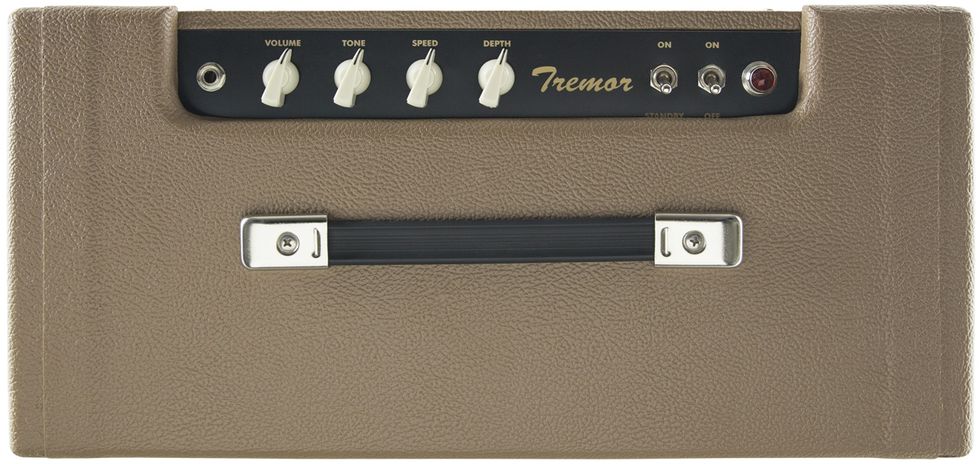RatingsPros:Terrific tweed-style tones. Bargain price for a good handwired amp. Cons: Trem circuit produces pops/clicks at higher depth settings. Street: $1,163 street (as reviewed with Weber alnico 12A125A speaker) Winfield Amps Tremor winfieldamps.com | Tones: Ease of Use: Build/Design: Value: |
The Tremor is a 12-watt combo from Arizona amp builder Winfield Thomas. It’s a near-clone of the Fender Harvard, a dual-6V6 tube model produced from 1955 through the end of the decade. Or maybe it’s more accurate to call it a tweed Vibrolux clone. That amp was simply a Harvard with a different preamp tube, plus the tremolo circuit that the new part permitted.
A couple of things about the Harvard: Its most famous user is soul session titan Steve Cropper. If there’s such a thing as a “sound of Stax” amp, the Harvard is it. Still, the amp was never especially popular, occupying an awkward middle tier between Fender’s entry level and pro models. It departed from its cathode-biased contemporaries with a fix-biased scheme—a design choice that tends to provide a little extra headroom and stouter lows.
Bigger and Browner
The Tremor’s main deviations from the original design are size upgrades: It has a larger output transformer (a 40-watt Weber) and an upscale 12" Weber 12A125 speaker in lieu of the original’s 10" Jensen. (Other 1x12 options include a Weber Blue Dog or Eminence Legend 1258, or a 1x10 combo with a Weber Blue Pup or a Legend 1058.) Cosmetically, it’s a tweed in brownface clothing. And the vinyl, by the way, is attractive and expertly applied. But note that the Tremor’s vibrato circuit is tweed-style, not the dual-tube “harmonic tremolo” of some Fender brownface models.
But the Tremor is most remarkable for the ways it cleaves to Fender tradition. This amp is truly made the old-fashioned way. Components are handwired on old-school grommet board. The assembly and wiring seem solid. Aside from an internally accessible bias-adjust pot and modern plastic tube sockets, this could almost pass for a late-1950s build. The same goes for the light, resonant solid pine cabinet.
Present and Accounted For
I recorded the first audio clip immediately after unboxing the amp and warming the tubes. I used my “Don’t make me come over there!” test: I maxed the amp volume, parked the single treble-cut tone control at noon, and sat across the room, controlling tones from the guitar (a DIY semi-hollowbody with humbucking TV Jones Filter’Tron pickups). As you’d expect from a tweed-style amp, the dynamic response is superb. You could play an entire gig with the amp set this way, regulating distortion from your guitar’s volume control.
Speaking of gigs: You’d probably need to mic this amp for all but low-volume performances. Still, the Tremor is more assertive than many amps its size. Tones are ultra-present, with crisp transients, lovely natural compression, and airy resonance. Between the fixed-bias design and the bold alnico Weber speaker in our test combo, the amp dispenses startlingly powerful lows. You hear some of that in the second audio clip, which showcases various amp settings.
More Shout, Less Screech
The bias and speaker design choices also affect the most controversial aspect of tweed amps: their high-volume performance. Whenever I review a tweed-style amp, some friendly reader inevitably points out how my high-gain clips sound like crap. Crap is in the ear of the beholder, of course. And with most tweed-derived designs, you shouldn’t expect creamy high-gain distortion. Think jagged Neil Young.

Here, though, the modest extra headroom and full-bodied speaker provide stouter, less fizzy high-gain tones. This isn’t, to use that popular and annoying phrase, “a clean platform for effects.” It’s pretty much the opposite. But players who a) love the presence and supreme dynamic response of tweed designs, but b) flinch at their potentially shrill high-gain tones may find the Tremor a satisfying compromise. My third and final clip adds effects: Plate reverb to soften the amp’s ultra-present attack, and a hot germanium booster at an aggressive setting. The note definition is excellent, considering how hard I’m slamming the amp’s front end.
Tricky Trem?
The Tremor’s core tremolo sound (which is activated by the classy included foot pedal) is quintessential tweed—a beautiful thing! (The phrase at the start of the second audio clip is a good example.) That said, our review unit exhibited some issues with the trem rate and depth controls. While the depth pot sounds fab in the first third of its range, settings around 10 o’clock produced “beating”—audible popping/clicking speaker noises. The phenomenon was even more noticeable at higher depth settings. Is this a deal-breaker? Listen carefully on headphones and decide for yourself. (Responding to this point, Thomas says the tremolo was designed for smooth, click-free response, so it’s possible the clicking sound we observed was an anomaly induced by rough handling in transit.)
The Verdict
The Tremor captures a classic tweed tone while adding a touch of extra headroom and frequency range that even tweed traditionalists are likely to dig. It’s a fine recording amp, with crisply etched tones that’ll suit many mixes. It’s easy to feel like Steve Cropper at a 1960s soul session whenever you play slow arpeggios or strike a bright backbeat chord.
The ranges of the trem’s rate and depth controls are problematic for me, so interpret my “tones,” “build/design” and “value” ratings of 4 accordingly. (If you plan to use the trem only at modest settings, upgrade those numbers to 5. If you want deep trem, downgrade them to 3.) Also, this is an excellent price for a great-sounding handwired amp, and you can lower the cost further if you opt for a less pricy speaker or the $775 head-only model.















